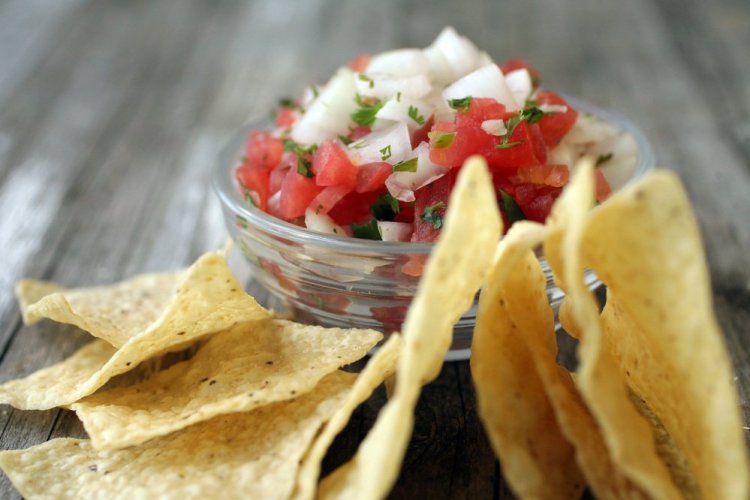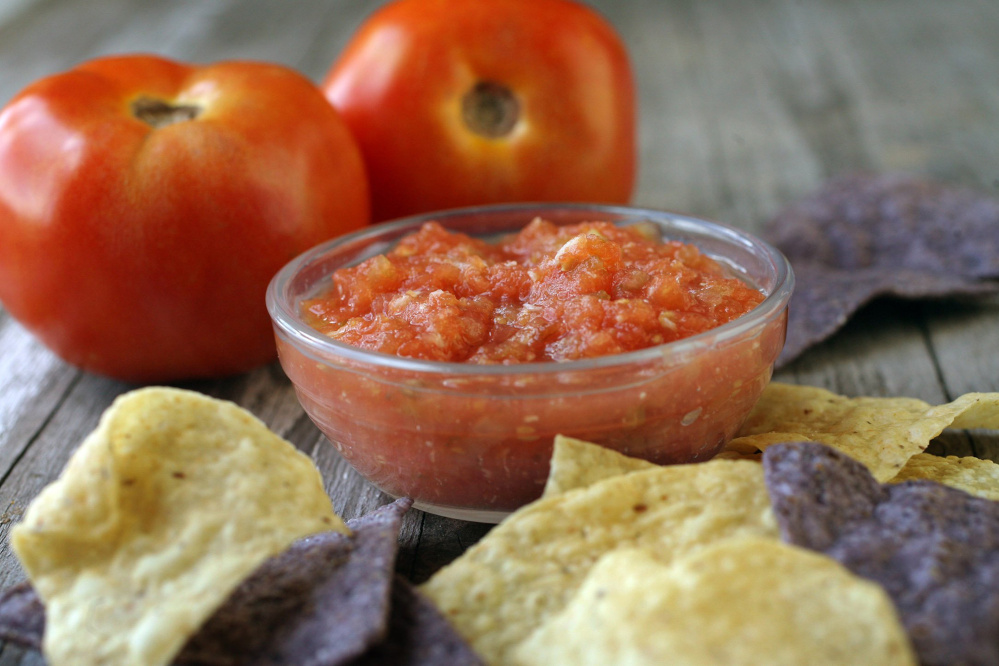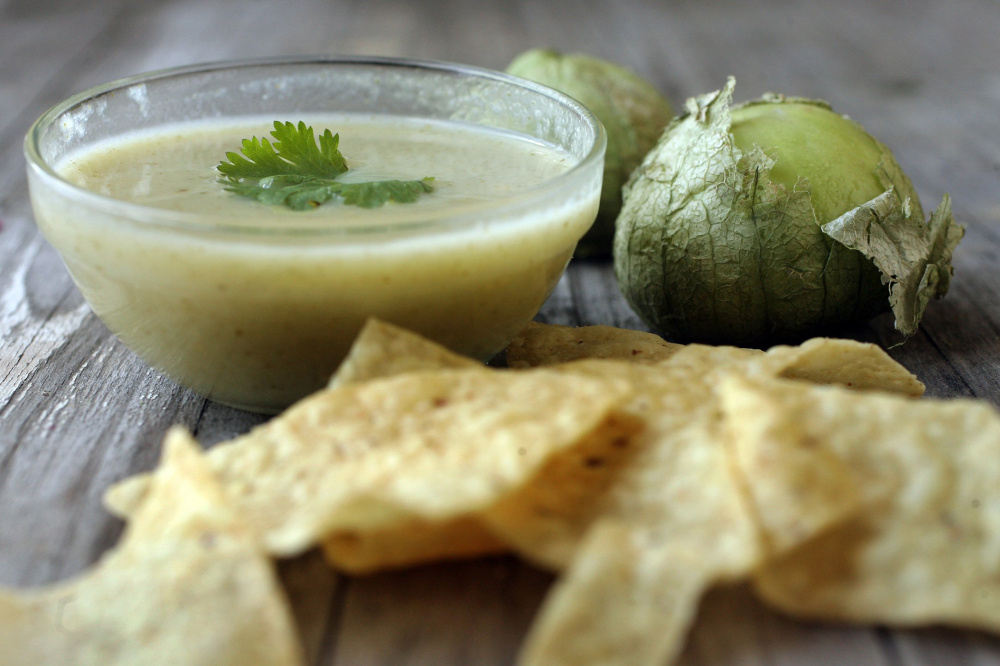Goodbye, McDonald’s. Hello, Chipotle.
It has been some years now since salsa overtook ketchup as America’s favorite condiment. Americans buy more tortillas than hamburger or hot dog buns and more tortilla chips than potato chips.
Mexican food – or at least Tex-Mex, which is one narrow slice of the giant pie that is Mexican cuisine – has become assimilated. It is now so popular that a lot of people no longer even think of it as Mexican anymore; it is just American.
The all-American foods they supplanted, hamburgers and hot dogs, were once considered ethnic, too.
In celebration of this Americanization of Mexican food – but really just because fresh tomatoes are so good and abundant right now – I decided to take a look at salsa.
I didn’t want to do anything too fancy. This time out I wanted to stick with the basics.
Peach salsa is fine, but most people aren’t going to make it more than once or twice a decade, if that. Mango salsa is also special, but I’ll bet it is made even less often than peach salsa.
I made one green salsa, one white and one red. Those are the colors of the Mexican flag. True, the white salsa isn’t exactly white, but it has a lot of white in it in the form of chopped onion. So green, white and red salsas is my story, and I’m sticking with it.
Green salsa, salsa verde, can be served either cooked or raw. Raw salsa verde has a brighter, fresher taste, but I prefer the subtle complexity of the cooked green salsa.
Green salsa, of course, begins with tomatillos, those husk-covered green fruits that resemble tomatoes (they’re both members of the nightshade family, but so are potatoes and eggplants). If you have never cooked with them, there is no need to panic. You simply pull off the husk and give them a good rinse.
Cook the tomatillos in water with a white onion, garlic and small, thin serrano chiles. I started with just one serrano with the seeds removed (much of the heat is concentrated in the seeds), but that wasn’t hot enough for my taste, so I added another serrano with its seeds. That was just right for me, but a little too ebullient for some of the taste testers.
The secret of this salsa verde is that the vegetables are pureed with the water in which they are cooked. It takes less than 45 minutes to make from start to finish, and the result is absolutely spectacular. I’d say it is the best salsa I’ve ever made. It is a warming, earthy and multifaceted taste sensation.
For my white salsa – well, sort of white – I made pico de gallo. It is perhaps the most basic of all salsas, but it creates a tremendous amount of flavor out of very little effort.
To make a pico de gallo, all you have to do is chop up a couple of tomatoes, a sweet onion, some jalapeño, a bit of garlic, a sprinkling of cilantro and a splash of lime.
Add salt to taste and you will end up with a salsa that will make you a hit at any party. Your friends will ask you to make it again and again – which is fine, because it’s so easy.
For my genuinely red salsa, I used a recipe given to me a few years ago by a former colleague, Olivia Herrera. Olivia is a truly superb cook, and she showed me two tricks to making salsa that brings out the very best of the ingredients.
The first is diversity. Olivia (and now I) use three different kinds of peppers to give the salsa a multiplicity of flavors – a spicy serrano, a couple of mild Anaheims and a trusty jalapeño.
The other trick is roasting. Before pureeing her ingredients, she puts her peppers, tomatoes, garlic and onions on a pan over medium heat and cooks them until they are charred and blistered on all sides. By that point, they are cooked through. You just remove the skins and puree the tomatoes, peppers and garlic and blend them all together until the salsa becomes the consistency you like (I like mine just a little bit chunky).
Then you simply stir in the cooked onions, along with optional cilantro and salt.
The salsa is out of this world. It will be unlike any other you’ve ever had. No wonder salsa is so popular.
SALSA VERDE
Yield: About 36 ounces
1 pound tomatillos
1 medium white onion, quartered
1 to 3 serrano peppers, seeds removed (if desired) for less heat
4 garlic cloves
12 sprigs of cilantro
2 tablespoons oil
1 teaspoon salt
Pull the husks from the tomatillos and rinse to remove sticky residue. Place tomatillos, onion, peppers and garlic in a large pot and just cover with water. Bring water and ingredients to a boil, lower the temperature and simmer for 10 minutes.
Transfer the cooked ingredients to a blender, along with the cilantro and 2 cups of the cooking liquid. Blend until smooth, about 30 seconds. If too thick, add more cooking liquid until desired texture.
Add 2 tablespoons oil to the pot on high heat. Pour the blended salsa into the pot. Reduce the heat and simmer for 20 minutes. Stir in the salt and adjust seasonings if necessary.
Adapted from mexicanfoodjournal.com
PICO DE GALLO
Yield: About 5 cups
2 large tomatoes, chopped
1 cup sweet onion, chopped
1/2 jalapeño, or to taste, chopped
1 clove garlic, minced
2 tablespoons cilantro, chopped
Juice from 2 to 3 lime wedges
Salt to taste
Mix together all ingredients. Serve immediately or refrigerate for up to 24 hours.
OLIVIA’S SALSA
Yield: About 1 quart
1 serrano pepper
2 Anaheim peppers
1 jalapeño pepper
6 to 10 tomatoes, mixed, regular and Roma (plum)
3 garlic cloves, unpeeled
1/2 large onion, sliced in rings
Fresh cilantro, optional
Salt
Place a large skillet or skillets over medium heat. Add the peppers, tomatoes, garlic and onions (you may wish to do this in batches). Cook, turning frequently, until they soften and the skin begins to blister all over. When cool enough to touch, peel and discard the skins. If less spicy heat is desired, remove some or all of the seeds from the peppers.
Place the peppers, tomatoes and garlic in a blender or food processor and blend until the salsa reaches your desired texture. Chop the onions and add, along with the optional cilantro. Salt to taste.
Send questions/comments to the editors.





Comments are no longer available on this story